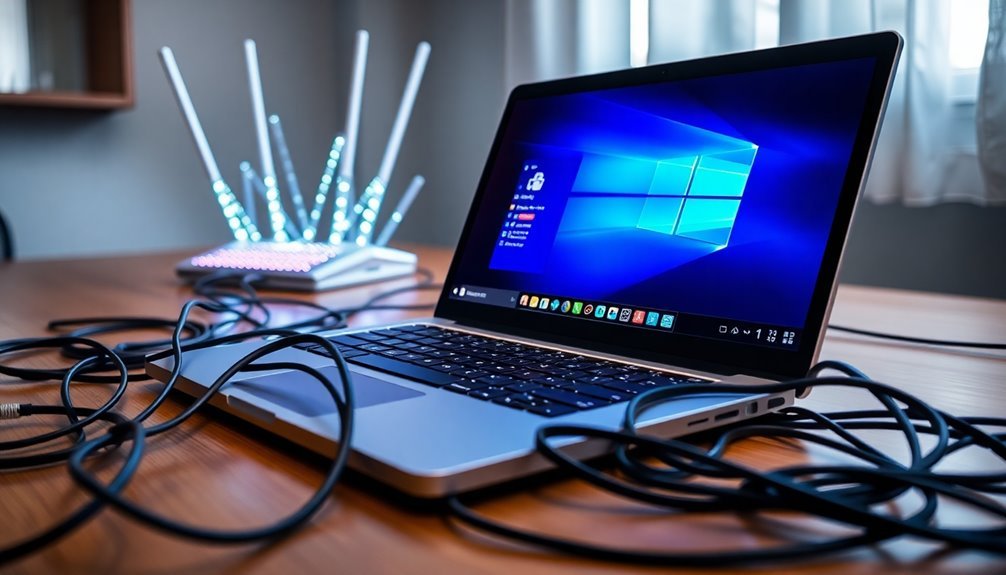Diagnose Connection Problems Windows 7: Network Diagnostic Tools

To diagnose connection problems in Windows 7, you can utilize built-in network diagnostic tools. Right-click the network icon and select “Diagnose” to initiate automatic troubleshooting.
Command-line utilities like Ipconfig and Netstat are essential for monitoring your network configuration and connections. You can also use the Netsh command for more in-depth tracing.
These tools efficiently identify common issues and offer useful fixes, helping to ensure your network runs smoothly. You’ll find additional methods to enhance your troubleshooting skills shortly.
Overview of Windows 7 Network Diagnostic Tools

When encountering network connectivity issues on Windows 7, the built-in diagnostic tools can serve as essential resources for troubleshooting.
To access these helpful tools, simply right-click the network icon in the system tray and select “Diagnose.” This feature offers a straightforward interface to pinpoint wireless connection problems, providing valuable insights into your connectivity status and network adapter configurations. The diagnostic tool will conduct the diagnosis to identify any existing problems with your network connection.
The automated troubleshooting steps guide you through common network issues, such as resolving IP conflicts or DNS resolution failures, ensuring a seamless diagnostics experience.
Additionally, the Wireless Network Report generates comprehensive logs that encapsulate session success and failure points, reasons for disconnections, and detailed IP configurations. You’ll also receive pertinent information about stored networks and their encryption status, all while safeguarding sensitive data.
These diagnostic tools are conveniently integrated within the Network and Sharing Center, enabling you to modify settings or run diagnostics without needing any third-party software.
Key Command-Line Network Utilities
To optimize your network troubleshooting efforts in Windows 7, it’s essential to be familiar with key command-line network utilities that can significantly improve your network management skills.
Here are some of the vital tools you should know:
- Ipconfig: This command displays your current TCP/IP configuration and allows you to refresh DHCP leases and DNS settings. For more detailed information, use the `/all` option to showcase comprehensive configuration details. Networking commands are instructed via the command-line interface, enhancing control and visibility during troubleshooting.
- Getmac: Quickly retrieve the MAC addresses of your network adapters using this utility. It’s particularly useful for managing network access control and ensuring device identification within your network.
- Nslookup: This command queries the DNS to resolve domain names into IP addresses. It’s invaluable for diagnosing DNS-related issues as well as verifying the accuracy of DNS records, making it an essential tool for network administrators.
- Netstat: This utility provides information on active TCP connections and listening ports. It assists you in monitoring network activity, enabling you to identify any unusual sessions or potential threats to your network.
Using Netsh for Network Tracing and Diagnostics
To effectively stop a network trace and finalize your log for detailed analysis, simply use the command netsh trace stop.
The trace files generated, saved in the .etl format, are crucial as they contain essential insights, including DHCP requests, which are invaluable for identifying network issues such as missing responses.
Additionally, improve your troubleshooting process by utilizing the diagnose command.
This command helps to reveal known network problems and generates informative reports.
Steps to Run Network Diagnostics
If you’re experiencing connectivity issues on Windows 7, running network diagnostics can help you identify and resolve these problems quickly and effectively.
Follow these simple steps to run network diagnostics:
- Access Network and Sharing Center: Right-click on the network icon located in your system tray and select Open Network and Sharing Center.
- Change Adapter Settings: Click on Change adapter settings to view all your available network adapters.
- Diagnose Your Network Adapter: Identify the active network adapter (such as Wi-Fi or Ethernet). Right-click on it and choose the Diagnose option.
- Run Diagnostics: Allow Windows to perform tests on hardware status, IP configuration, DNS lookup, and connectivity.
Once the diagnostics process is complete, review the generated report to find out what issues were detected.
You’ll be provided with recommendations for resolving these problems, which may include resetting adapters or updating drivers.
If the automated solutions don’t resolve the issue, you may need to take further manual steps.
It’s a good idea to document your results for future reference or for escalation to advanced support.
By following this straightforward approach, you can streamline your network troubleshooting process in Windows 7.
Keywords: Windows 7 network diagnostics, troubleshoot connectivity issues, network adapter settings, diagnose network problems, fix network issues.
Additional Diagnostic Tools and Their Functions

When troubleshooting network connectivity issues on Windows 7, running network diagnostics is a vital first step. However, utilizing additional diagnostic tools can provide deeper insights into your network problems. The Netsh.exe command-line utility is a powerful resource that enables you to manage network configurations and perform scenario-based tracing while capturing detailed telemetry data.
For those who prefer a visual method of analysis, Network Monitor (NetMon) offers packet-level examination, which can reveal critical issues such as dropped packets or protocol errors. Additionally, the Event Viewer is an essential tool that allows you to filter system events, specifically for network-related alerts.
To gain a clearer understanding of your network’s performance, Tracerpt.exe can convert trace logs into easily readable reports. Built-in TCP/IP command-line tools, including Ping and Tracert, are also indispensable for verifying connectivity and measuring path efficiency.
Microsoft’s Network Diagnostic Tool is designed to scan for common network issues, ensuring that you can quickly identify and rectify problems. For advanced performance tracing, Xperf.exe is an excellent choice.
Benefits and Limitations of Diagnostic Tools
Understanding the advantages and disadvantages of diagnostic tools is crucial for effectively troubleshooting network issues on Windows 7.
These essential tools can significantly save time and effort by automating many troubleshooting processes, though they do come with certain limitations.
- Efficiency: These tools can quickly detect common issues such as misconfigurations and performance bottlenecks, making it easier to resolve network problems efficiently.
- Security Monitoring: Diagnostic tools can identify unauthorized access attempts and suggest necessary security enhancements, ensuring your network remains protected.
- User Experience: By minimizing downtime and offering visual representations of your network, these tools can enhance productivity for users and IT professionals alike.
- Limitations: Despite their benefits, diagnostic tools may overlook complex issues, necessitate manual interpretation, and may not perform optimally with outdated drivers.
While diagnostic tools streamline the troubleshooting process, their constraints necessitate that they’re used in tandem with your expertise to ensure a thorough analysis and resolution of network issues.
Striking the right balance between automated diagnostics and manual checks will enhance your overall network management strategy.
Frequently Asked Questions
How Do I Disable Network Diagnostics in Windows 7?
To disable network diagnostics in Windows 7, access the Run dialog, type `msconfig` or `services.msc`, find Diagnostic Policy Service, uncheck or set it to Disabled, then restart your computer for changes to take effect.
Can I Reset My Network Settings to Default in Windows 7?
Yes, you can reset your network settings to default in Windows 7. Picture a fresh start—run commands like `netsh winsock reset` and `ipconfig /flushdns`, then restart your computer to regain smooth connectivity.
What Should I Do if Diagnostic Tools Fail to Fix Issues?
If diagnostic tools fail, try restarting your modem and router, check network adapter settings, or reinstall drivers. You might also contact your ISP for help or explore specialized forums for additional solutions.
Are There Any Third-Party Alternatives for Network Diagnostics?
Yes, over 70% of network issues can be diagnosed using third-party tools. Consider options like Wireshark for packet analysis or PRTG for real-time monitoring. They enhance your troubleshooting with detailed insights and user-friendly interfaces.
How Can I Increase Ping Response Accuracy in Testing?
To increase ping response accuracy, adjust packet size, set a short timeout, and conduct multiple tests. Use consistent intervals and analyze results thoroughly, considering both latency and packet loss for a clearer network picture.
Conclusion
In conclusion, mastering Windows 7’s myriad of network diagnostic tools can dramatically decrease connection complications. By deftly diving into command-line utilities and utilizing Netsh, you’ll streamline troubleshooting. While these tools offer significant support, they’re not foolproof—sometimes, solutions remain elusive. Remember, regular reviews and proactive practices can prevent persistent problems. Empower yourself with knowledge, and you’ll conquer most connectivity concerns before they cause chaos. Take charge, and enjoy a seamless surfing experience!





